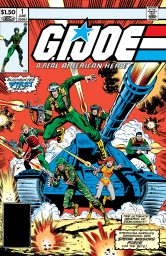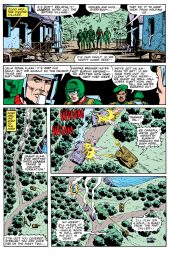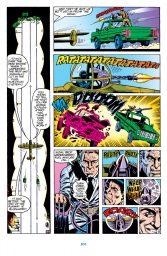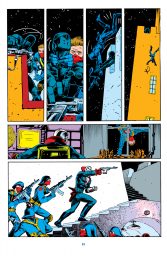G.I. Joe: A Real American Hero is one of those titles that you can either hang with, or it’ll drive you nuts. Unless you don’t care one way or the other. (THANKS FOR THE JOKE MITCH!)
Debuting in 1983, it told the stories about an elite team of counter-terrorism soldiers—drawn from every branch of the military—and their arch enemies, the terrorist cabal Cobra (as related on the iconic cover of the very first issue, right).
Based on the Hasbro toy line, it featured characters and equipment that could be called “somewhat unrealistic” at times, but could also be called “balls out insane and awesome”. Which side of that line you fall on will determine how you feel about the comic.
G.I. Joe began as a eponymous comic strip called “Private Breger” in The Saturday Evening Post in 1941 (and has been published in every single decade since). When the Army asked Breger to do a similar comic for Yank, the Army Weekly, he came up with the title G.I. Joe. The comic became toys (and a bunch of other stuff), and the toys in turn gave rise to Marvel’s G.I. Joe: A Real American Hero. I recently re-read the first two years of the comic—24 issues—so here’s some random thoughts.
This is an unabashed military adventure comic. If you set the colorful uniforms and freaky Sci-Fi tech aside, it could well be Sgt. Rock or Sgt. Fury and his Howling Commandos. Combat—including on-screen deaths, as this is the comic, not the Saturday morning cartoon show—is a staple of the series, as are spy thriller set pieces, outrageous terrorist plots, and tense “ticking clock” situations. People who loathe action-centric entertainment will loathe G.I. Joe.
The plots and settings are highly varied, right out of the gate. The first issue features an attack by Cobra on a military train to kidnap a nuclear weapons scientist, followed by a sea-air assault on Cobra Island to take her back. Issue #2 centers around an attack on American and a Russian research bases north of the Arctic Circle. A Cobra robot is the main opponent of Issue #3—the Joes brought it back to their HQ, where it reactivated, reassembled itself, and tried to fight its way out of the Pit. Variety is the key to any adventure series (cinematic, illustrated, or prose) and Larry Hama, the main writer of the series, certainly delivered.
The first year is episodic, each issue standing on its own. The start of the second year sees the introduction of running storylines, “story arcs” in the parlance of the industry, meaning that much of the time you can’t read an issue all by itself, you have to catch the whole arc to make sense of the story. Some of the issues suffered from this, being little more than interstitial continuations of previous storylines, lacking a clear plot or a payoff for the audience. In an episodic medium, where people have to wait a month between episodes, this is a significant weakness.
The art of the series was pretty much par for Marvel in the early ’80’s. It took a sharp drop about issue #5, but recovered over the next six or seven issues. (In addition to outright problems with the art, like failures of perspective, it apparently suffered from too-rapid inking, as a lot of the detail in the original pencils seem to have never made it to the page.) By the time the comic really hits its stride at the end of the second year, the art is mostly decent and only gets better from then on out.
The Joes and their foes are all given distinct personalities (many of which were carried over from the toyline), usually with some kind of twist. Roadblock, the black, muscle-bound heavy machine gunner, is also a gourmand and chef; Australian Major Bludd is a vicious mercenary who’s also well read (but an awful poet); Cover Girl, driver of the Wolverine tracked rocket artillery vehicle, is a former world-class model and and a girly girl, regularly checking her hair and makeup. This latter character is allowed to be unsure as she goes into her first combat, is allowed to get help from her male teammates when needed (but stands on her own when not needed), and is allowed to be attractive and feminine. The Joes have characters of all races and both sexes, a fact that just is and is never commented on or made an issue (at least in the first two years). Again, all this sharply contrasts with modern entertainment in so many ways.
In fact, the comic as a whole is far better than anyone would have the right to expect. The writer, Larry Hama, took the time to do research on real world military equipment and tactics, and inserted them wherever he could. He researched the proper checklist for taking off in a Lancaster bomber, plus the procedure to start up one of the engines which was missing a critical component. And inserted both without over-much exposition or a tedious lecture. The focus on accuracy kept the series grounded, lending verisimilitude to the more fantastic elements.
Larry Hama may not win any awards for his work on the series, but he’s a much better writer than the phrase “based on the Hasbro toy line” would indicate. He treats the Joes’ world seriously and respects the audience, something rare in any entertainment field (especially lately). He manages to tell interesting, action-filled stories which entertain the audience, the entire point of an entertainment medium.
The apex of the first two years, and perhaps the whole series (after #49-#50), is issue #21, “Silent Interlude”. The entire story is related visually, with no dialogue, internal monologue, or any other word boxes. Everything is communicated through characters’ postures, facial expressions, or actions. Despite this, the issue is dynamic and kinetic. The lack of talky bits forces a focus on the clear and unambiguous depiction of events, at which the comic absolutely succeeds.
Modern comics have all-too-frequently become little more than a vehicle for the author’s sexual peccadilloes or political obsessions, and sales have suffered for it. Reading G.I. Joe is a trip back into a time when ideological inculcation was nearly nonexistent, and the only thing that mattered was entertaining the audience. In that, the comic certainly succeeds.
Jasyn Jones, better known as Daddy Warpig, is a host on the Geek Gab podcast, a regular on the Superversive SF livestreams, and blogs at Daddy Warpig’s House of Geekery. Check him out on Twitter.
Hama was a Vietnam vet.
I was never a huge fan of the Joes, but I was always fine with the comic. I did buy issues which had Michael Golden art. Speaking of whom, the initial run of the MICRONAUTS with Golden was probably the best toy-inspired comic ever. As a (micro-)space opera, it blows away anything in Star Wars after “Empire”, IMO.
-
IIRC, Hama also originally pitched the Real American Hero concept as a Nick Fury/SHIELD revival. When that wasn’t approved, he reworked it so SHIELD became the Joes and Hydra became Cobra.
DWP, have you ever seen this series, which was started off by Wally Wood in the 1960s?
https://en.wikipedia.org/wiki/M.A.R.S._Patrol_Total_War
Wood did the first three issues, which were collected and released as a short TPB by Dark Horse.
Check out the Netflix series (only 4 or 5 episodes) of The Toys That Made Us. There’s an episode dedicated to G.I. Joe and Larry Hama is interviewed.
According to the show, Larry Hama was given the job of writing the Joe and Cobra dossier cards on the back of the action figure packages.
A very interesting show. Hama took his job seriously, like any competent professional.
I️ Love the comics! Hama is a great comic writer, his stuff for G.I.JOE only got better as it went on. The 20’s thru the 60’s are amazing. And then the spinoff issues titled special missions went for an even more realistic (non-Cobra) anti-terror milieu.
Hama also did the best Wolverine run for Marvel too, once he quit I️ pretty much quit reading it because nobody could compare.
I think a “Hidden Gem” is the “Graphic Toy Commercial” that mainly Marvel did so well…
Micronauts.
Rom.
GI Joe.
Star Wars – the original “Expanded Universe”
Crystar, Inhumanoids…
Simply put, a big comic company to make more $ or to do a favor for another toy company makes a comic to promote the toy. The toy lasts for a while and the writers realize they haven’t been cancelled yet…
Well, like a cool Muppet Show – “the show must go on…” – “Why?” – “Well if it doesn’t we don’t get paid…” – “The Show MUST Go ON!”
And so relatively untouched writers and artists really worked hard using the limited characters and plot settings to make neat stories and tried to weave neat stories with layers of meanings.
Upwards was pointed out how epic Micronauts was.
Another cool thing was ROM the Spaceknight – the best part was the last 2 years where they had the Wraith war finished and Rom traveled through the galaxy to search for lost spaceknights to tell them the war was over. He was kind of like a white night motorcycle guy going on a road trip to purge his inner pain. This was written by 60s people, but not soapy or sappy – they’d known the Vietnam war as a social issue, had friends and family serving – ROM was an intelligent way to deal with it – the “Wraith War” was justified, Rom himself a poet and pacifist, he’d likely have gone to jail to avoid serving but couldn’t bear the shame of another being forced to fight in his place. He then -at least physically – lost his humanity in the war and dealt with that – one of the best issues where he tried to be a peacemaker in a world where humans and machines fought each other. It was pretty intelligent and deep for a comic meant to be a toy commercial.
I very much enjoyed the Marvel GI Joe comic book for the first five years of its run, and also the old TV cartoon to a lesser extent.
But when I realized that any character that had a toy figure was safe from death, it took some of the enjoyment away. I do recall a couple of heroes dying very early on, and I heard that much later in the comic some Joes were killed, but I thought the story could have been better with the occasional toy character making the ultimate sacrifice in desperate situations.
If you ever liked the GI Joe TV show, you should check out the Community GI Joe TV episode, I found it hilarious.



